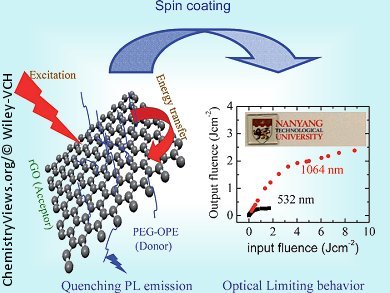Optical limiters can protect sensors or human eyes from optical damage as they block transmission of high intensity light, but permit transmittance for low level inputs.
Hua Zhang and Handong Sun and their teams, Nanyang Technological University, Singapore, have reported the optical limiting (OL) properties of the new amphiphilic graphene composite PEG-OPE-rGO (PEG = poly(ethyleneglycol), OPE = oligo(phenylene ethenylene), rGO = reduced graphene oxide). The coil-rod-coil structure of this conjugated triblock copolymer (PEG-OPE) was used to functionalize the graphene and provide the super dispensability in a variety of solvents.
The composite harnesses the broad optical limiting effect of graphitic systems to give enhanced non-linear optical (NLO) performance in solution and when fabricated into highly transparent thin films (pictured). When excited with 532 and 1064 nm nanosecond pulses, the thresholds for OL properties are better than those of other graphene composites. The main factors that contribute to the enhanced OL response are a combination of multiphoton absorption and energy transfer.
The excellent OL response of PEG-OPE-rGO allows it to be one of the best candidates in practical optical limiters.
- Enhanced Optical Nonlinearity in Noncovalently Functionalized Amphiphilic Graphene Composites,
T. He, X. Qi, R. Chen, J. Wei, H. Zhang, H. Sun,
ChemPlusChem 2012, 8.
DOI: 10.1002/cplu.201200113
This article is available for free as part of the ChemPlusChem free trial.
- Issue 8 of ChemPlusChem coincides with the 4th EuCheMS Chemistry Congress, organized by the European Association of Chemical and Molecular Sciences (EuCheMS) and the Czech Chemical Society, in Prague. The predecessor journal, Collection of Czechoslovak Chemical Communications, originated from here.
Issue 8 provides a first class cross section of papers by the three Chairmen and selected Board Members that highlight the high-impact multidisciplinary research published in ChemPlusChem.




